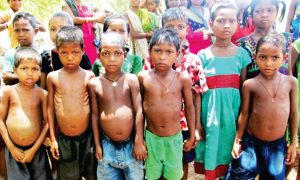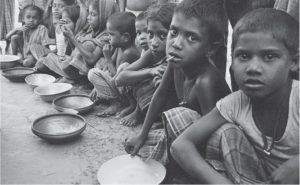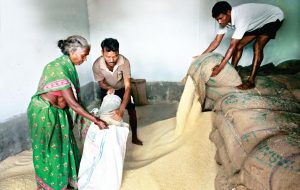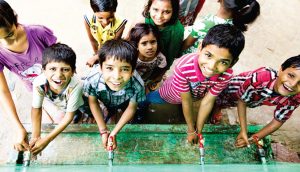
Currently, there are 795 million hungry people in the world and India itself is home to the largest under-nourished and hungry population, with 195 million people going hungry every day. That is the plight of India with respect to malnutrition.
WHO defines malnutrition as “deficiencies, excesses or imbalances in a person’s intake of energy and/or nutrients. The term ‘malnutrition’ covers two broad groups of conditions. One is ‘under nutrition’ which includes stunting (low height for age), wasting (low weight for height), underweight (low weight for age) and micronutrient deficiencies or insufficiencies (a lack of important vitamins and minerals). The other is overweight, obesity and diet-related non-communicable diseases (such as heart disease, stroke, diabetes and cancer).” To put it simply, malnutrition refers to either an individual suffering from under nutrition or over nutrition, although we usually conceive malnutrition as only under nutrition. Over nutrition or obesity is as much of malnutrition as it still comes under the purview of having imbalanced intake of nutrients.
“Although we might have succeeded in saving our girl child, we have not yet succeeded in feeding them. Data from Bihar and Madhya Pradesh shows that girls represent up to 68 percent of the children admitted to programmes for the severely malnourished. If this same vicious cycle continues, the struggle for a healthy India may get even harder and longer to combat”
 So what exactly are the root causes of malnutrition and why has India been struggling with this evil for decades now? To begin with, gender bias can be looked upon as one of the root causes of malnutrition in India. To validate this point, let us look at the fact that although women make up a little over half of the world’s population, they account for 60 percent of the world’s hungry. In India, nutrition of children is particularly worse because of the state of their mothers. 36 percent of Indian women are chronically under-nourished right from childhood. This can be attributed to the fact that girl children are less wanted in a patriarchal society like India; where men receive food before women. Even though we might have succeeded in saving our girl child, we have not yet succeeded in feeding them. Data from Bihar and Madhya Pradesh shows that girls represent up to 68 percent of the children admitted to programmes for the severely malnourished. If this same vicious cycle continues, the struggle for a healthy India may get even harder and longer to combat.
So what exactly are the root causes of malnutrition and why has India been struggling with this evil for decades now? To begin with, gender bias can be looked upon as one of the root causes of malnutrition in India. To validate this point, let us look at the fact that although women make up a little over half of the world’s population, they account for 60 percent of the world’s hungry. In India, nutrition of children is particularly worse because of the state of their mothers. 36 percent of Indian women are chronically under-nourished right from childhood. This can be attributed to the fact that girl children are less wanted in a patriarchal society like India; where men receive food before women. Even though we might have succeeded in saving our girl child, we have not yet succeeded in feeding them. Data from Bihar and Madhya Pradesh shows that girls represent up to 68 percent of the children admitted to programmes for the severely malnourished. If this same vicious cycle continues, the struggle for a healthy India may get even harder and longer to combat.
India is one of the largest democracies in the world. It has witnessed a surge in the business sector. Despite the economic boom, there are still many social evils prevailing in India, impacting the society and development of the nation as a whole. One of the biggest evils among these is malnutrition. Each year, many innocent children lose their life due to malnutrition as they do not only get enough food, and even when they do, it is of low quality. To add to this drawback, lack of health facilities, cleanliness and awareness are further aggravating the problem. This situation has grown so grave that at present it calls for immediate action. When looked upon closely, we will find that there is enough food to feed everyone in the world. India has enough food and resources that all her deprived children can be fed. However, despite phenomenal industrial and economic growth and while India produces sufficient food to feed its population, it is unable to provide access to food to a large number of people, especially women and children. Despite availability of such abundant resources, data shows that each year, many children continue to die of malnutrition. On one hand we talk about development, while on the other, our children are not getting enough food. Let us take a look: where Gross Domestic Production has increased 4.5 times and per capita consumption has increased three times, similarly, food grain production has also increased almost two times.
“India is hungry. Not just for economic development and social justice, but for grain, for vegetables, for fruit, for seed, for poultry, for milk. The most critical kind of hunger is the hunger of both the father and the child for survival”
 India is hungry. Not just for economic development and social justice, but for grain, for vegetables, for fruit, for seed, for poultry, for milk. The most critical kind of hunger is the hunger of both the father and the child for survival. India has the highest number of children in the world suffering from malnutrition. This is a wake-up call for us. The government is now working towards the problem of malnutrition and has come up with a campaign ‘Malnutrition Quit India’, which was launched by the Ministry for Women and Child Development (MWDC), Government of India in November 2012. There are also many other programmes that have been initiated before this, having the same objective of feeding every child of India. Midday Meal Scheme by the Akshaya Patra Foundation, Integrated Child Development Scheme, National Rural Health Mission, Balwadi Nutrition Programme, are a few among these. India at present needs more initiations of these kinds. These initiatives can bear fruit but only with the sincere involvement of the people handling these campaigns. Every single grain should reach the neediest person instead of rotting in warehouses. There should be no corruption involved in such a noble cause.
India is hungry. Not just for economic development and social justice, but for grain, for vegetables, for fruit, for seed, for poultry, for milk. The most critical kind of hunger is the hunger of both the father and the child for survival. India has the highest number of children in the world suffering from malnutrition. This is a wake-up call for us. The government is now working towards the problem of malnutrition and has come up with a campaign ‘Malnutrition Quit India’, which was launched by the Ministry for Women and Child Development (MWDC), Government of India in November 2012. There are also many other programmes that have been initiated before this, having the same objective of feeding every child of India. Midday Meal Scheme by the Akshaya Patra Foundation, Integrated Child Development Scheme, National Rural Health Mission, Balwadi Nutrition Programme, are a few among these. India at present needs more initiations of these kinds. These initiatives can bear fruit but only with the sincere involvement of the people handling these campaigns. Every single grain should reach the neediest person instead of rotting in warehouses. There should be no corruption involved in such a noble cause.
Despite all these programmes, millions of people in India are still living below the poverty line, are malnourished, because the surplus food grains that we have is evidently not reaching to the ones who need it the most. This is a major ongoing problem and a battle that has to be won. The root cause for this can be attributed to corruption and mismanagement within committees, organisations and concerned individuals. The government has opened up subsidised food shops that get funds from the Public Distribution System (PDS) in various rural areas and villages. These shops are supposed to give out 35 kg of rice or grain a month to every family living below the officially declared poverty line, but most of the time, these shops lack supply to meet the demand.
 Over time, observation helps us deduce that no single ministry or intervention has been able to lead to rapid reductions in under-nutrition burden; which simply implies that delivering a set of essential nutrition interventions from diverse sectors of India is essential to create environments that foster optimal child growth and better nutrition for all. Few countries like Bangladesh, Brazil, Senegal, Vietnam and Thailand have undertaken fitting interventions which have led to dramatic improvements.
Over time, observation helps us deduce that no single ministry or intervention has been able to lead to rapid reductions in under-nutrition burden; which simply implies that delivering a set of essential nutrition interventions from diverse sectors of India is essential to create environments that foster optimal child growth and better nutrition for all. Few countries like Bangladesh, Brazil, Senegal, Vietnam and Thailand have undertaken fitting interventions which have led to dramatic improvements.
This is exactly where CSR can step in and make a difference, make each grain count. India is the only country in the world with a legislated CSR. The new law mandates that all companies, including foreign firms, which either has a net worth of Rs 500 crore or a turnover of Rs 1,000 Crore or net profit of Rs 5 Crore, needs to spend at least two percent of its average net profit forthe immediate preceding three financial years on corporate social responsibility activities. Shining examples of such efficient CSR can be seen below:
i) Chennai: Save the Children launched Aaharam (an extension of the Mission Nutrition was launched by its partner GlaxoSmithKline). This project raised awareness about malnutrition causes among mothers, families and communities. It was carried out across 20 notified slums of Chennai and 15 villages in the Tiruvallur district.
Activities included regular malnutrition screening of children (especially between ages 3-6); Community Case Management of undernourished children; nutrition education – with regard to feeding practices of young children; follow-upon malnutrition-afflicted children; improving community access to nutritious food through locally available food items.
 ii) Maharashtra: Save the Children (in partnership with the Rajmata Jijau Mother – Child Health and Nutrition Mission of Government of Maharashtra) implemented its Village Child Development Centre (VCDC) model to treat malnourished children. This scheme works at 30 Integrated Child Development Scheme (ICDS) centres with support from local Anganwadi workers in tribal areas in the Thane district to screen the young for malnutrition. The malnourished get regular meals, treatment for infections, as well as receive anti-parasitic and Vitamin A supplements.
ii) Maharashtra: Save the Children (in partnership with the Rajmata Jijau Mother – Child Health and Nutrition Mission of Government of Maharashtra) implemented its Village Child Development Centre (VCDC) model to treat malnourished children. This scheme works at 30 Integrated Child Development Scheme (ICDS) centres with support from local Anganwadi workers in tribal areas in the Thane district to screen the young for malnutrition. The malnourished get regular meals, treatment for infections, as well as receive anti-parasitic and Vitamin A supplements.
iii) Stop Diarrhoea Initiative: WASH Diarrhoea and malnutrition are closely linked to poor hygiene (infections trigger mineral depletion and loss of appetite and can lead to malnutrition) which is also India’s two leading causes of under-five deaths.
Such examples can further motivate other companies to take up lawful CSR and make the most out of it – by investing money back into the society and touching millions.
While CSR can be one of the efficient and widespread ways of tackling this situation, other necessary measures can include immediate actions to change nutrition outcomes such as:
 One, appointing a Nutrition Secretariat as part of the Prime Minister’s Office. The Secretariat can help in ensuring that these priorities are met and are aligned with the overall development of our country. This would include both nutrition specific and nutrition-sensitive initiatives. Nutrition metrics can be used to track the progress just like we track economic progress through economic metrics. We can identify such suitable indicators.
One, appointing a Nutrition Secretariat as part of the Prime Minister’s Office. The Secretariat can help in ensuring that these priorities are met and are aligned with the overall development of our country. This would include both nutrition specific and nutrition-sensitive initiatives. Nutrition metrics can be used to track the progress just like we track economic progress through economic metrics. We can identify such suitable indicators.
Two, create a nodal ministry accountable for revamping the ICDS, MDM, PDS with clear goals, timelines and resources. These can also be opened up for public-private partnerships and make these CSR-eligible by inviting corporate firms which will create a sustainable impact of CSR activities on the local communities.
Three, we can also consider extending large-scale food fortification beyond salt to other staples like flour, oil, dairy, etc., and establish mandatory standards by category.
Four, invest in information, awareness and education about good nutrition practices, extending from a diverse diet to de-worming, breast feeding, hygiene and sanitation, etc. Nutrition can be complex and therefore it needs to be simplified in behavioural terms for the public to understand and grasp.
India has a huge potential and it must convert its young population to a competitive advantage. This can be done only if nutrition and health are foundational to that outcome. While a lot of young people are taking up entrepreneurship, sensitising them to such issues and their possible contribution through CSR can go along way in shaping India’s future. According to data compiled by ratings agency Crisil, CSR spend has rose from Rs 2,500 crore to Rs 8,300 crore in fiscal 2016. This proves that the potential for CSR is huge in India, only if incorporated actively and judiciously. While we all make a living by what we get, it should be reinforced and remembered that we make a life by what we give.
Manish Handa is Director, Conexus Social Responsibility Services Pvt. Ltd.

